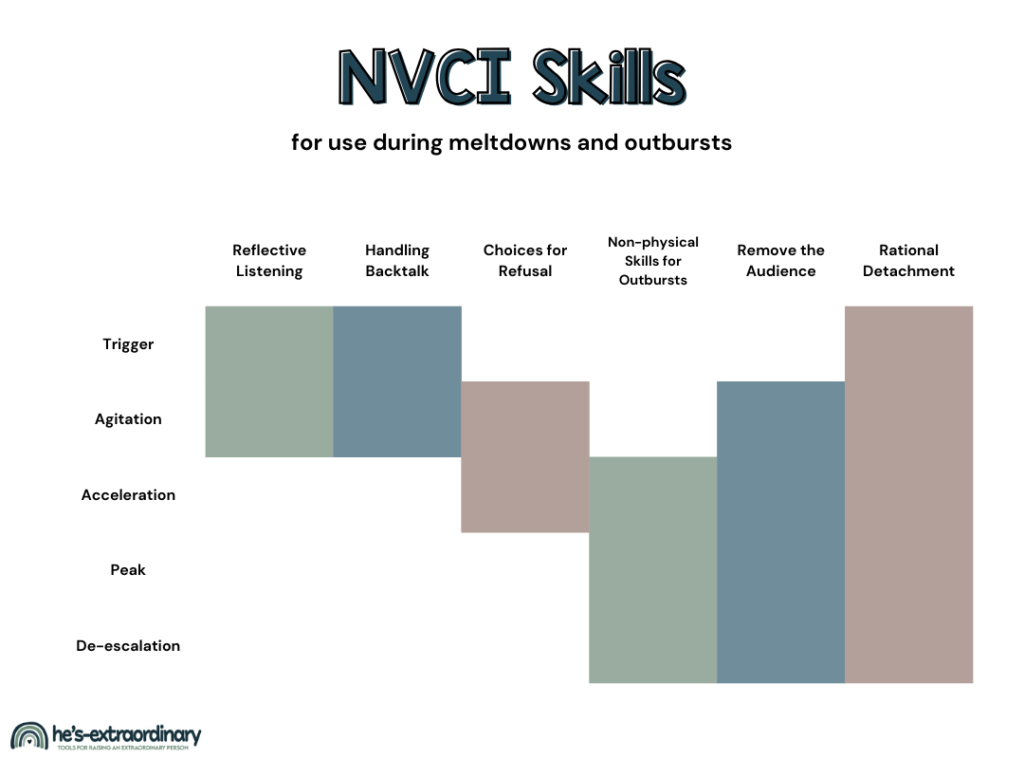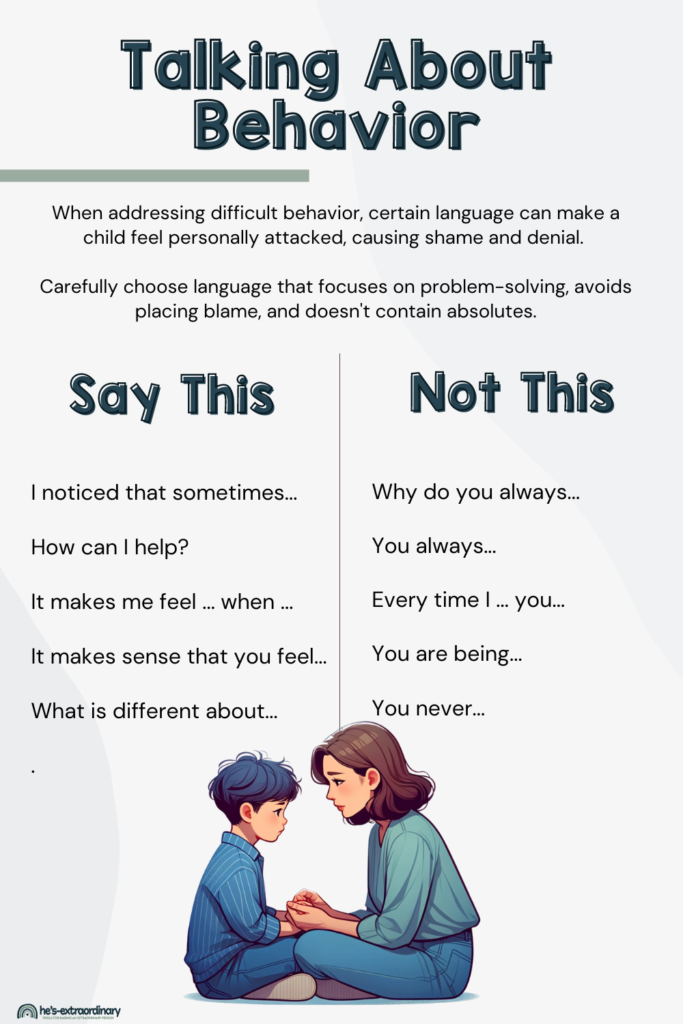6 Powerful NVCI Skills for Handling Meltdowns
What’s inside this article: 6 non-violent crisis intervention strategies that help with aggressive, threatening, or violent behaviors in children during meltdowns. These strategies help keep the child and others safe while remaining supportive of the individual having the meltdown. These are based on training from the Crisis Prevention Institute.
NVCI stands for Non-Violent Crisis Intervention, and it consists of various intervention techniques for aggressive, threatening, or violent behaviors. The goal of NVCI skills is to maintain the safety of everyone involved while being supportive and respectful of the individual.
This post will explain several valuable non-violent crisis intervention (NVCI) skills that may help you deal with your child’s meltdowns or outbursts.
However, it is not a substitute for a certified NVCI course.
If you frequently deal with meltdowns involving aggressive and violent behaviors, you should consider professional NVCI training. You can find training in your area here.
The Escalation Cycle
The escalation cycle is how I refer to the various stages of arousal or emotional state that your child progresses through when they are having a meltdown.

You can learn more about each stage of the escalation cycle, including what types of behavior to expect at each stage, as well as additional strategies you can use that are not part of the NVCI program by reading: The Ultimate Guide to Preventing Meltdowns.
NVCI Skills for Meltdowns & Outbursts
Six key NVCI techniques are covered in this article.
You can refer to this chart as a quick guide to remember what techniques work best during each stage of the escalation cycle.
Note: Everyone is different. Some children find certain strategies triggering that others find calming. If you know a strategy will escalate your child’s meltdown even more – don’t use it.
During a meltdown, you cannot discipline or reason with a child. Read over these 18 de-escalation strategies that are meant for the heat of the moment, and hopefully, you’ll find a few new ways to help calm your child during these difficult situations.

1. Reflective Listening
When to use: Trigger, Agitation
When your child is upset, they may have questions or concerns that, although they may sound trivial to you, are legitimate questions to your child.
Rather than shutting down their questions with abrupt answers like “because I said so,” practice reflective listening.
- Let your child talk, and focus on what they are saying.
- Focus on your child’s emotions – based on their tone of voice, body language, etc.
- Restate the question to confirm you know what they are asking
- Give a short and concise answer. Remain respectful, supportive, and empathetic as you address their concerns.
Emotion coaching is another great communication strategy that involves reflective listening and helps children learn to communicate and understand their emotions better.
2. Handling Backtalk and Attitude
When to use: Trigger, Agitation
Kids often express their anger through backtalk, and this can often trigger adults to become angry, too. Use the following strategies to calmly and effectively handle backtalk.
- Avoid negative reactions: Be aware of your own facial expressions, posture, and tone of voice. You must remain calm. Don’t react in a negative or aggressive way. For example, make sure you don’t cross your arms. – avoid afflictions in your voice that indicate frustration, impatience, and condescension.
- Respect personal space: Keep a distance of at least 3 feet from your child. Everyone’s personal space varies and can increase when agitated; this distance ensures you aren’t entering their personal space, which may make the situation worse or put you at risk of injury.
- Talk slowly: When a child’s upset, their verbal processing time increases. Talk slowly and use short, simple phrases. Avoid giving multi-step instructions.
- Make your expectations clear: Explain what the expected behavior is. Use clear, concise language. For example, instead of saying “Don’t do that,” try, “Sit down, please. We can take a short break, then work on your homework.”
- Stay on topic: Redirect back to the topic you were addressing if they change the subject. However, keep talking to a minimum. You should avoid back-and-forth arguments or power struggles.
3. Offering Choices for Refusal
When to use: Agitation, early acceleration
Your child may refuse to comply with a given demand either verbally or physically. For example, you ask your child to clean their bedroom and they verbally refusing by saying “no,” or they head to their room but they’re throwing things around instead of cleaning.
- Give your child two clear choices that are reasonable and appropriate.
- Explain the consequences/outcome of each of those choices
Example: First, you can clean your room, then we can watch a movie together, or you can go to bed early. You decide.
4. Remove The Audience
When to use: Acceleration, Agitation, Peak, Deceleration
Behavior may escalate faster when there is an audience.
This is not because your child is seeking attention or to “put on a show” – but because having other bystanders increase anxiety responses and may feel threatening to your child.
- Either remove the audience or remove your child: If it’s too difficult to remove your child in their current arousal state, then removing the audience is the best choice. This means having siblings, family members, friends, etc, move into another room while you manage the situation.
- Keep help on stand-by: If behavior often escalates to violence or the current situation is particularly hostile, have someone close by (but out of your child’s sight) who is ready to help.
- Increase your distance: Increase the distance between you and your child. Stay aware of your body language and tone of voice. Restate choices if possible.
5. Non-Physical Skills for Outbursts
When to use: Acceleration, Peak, De-escalation
Outbursts can be both verbal and physical. They can include screaming, yelling, crying, kicking, throwing, hitting, spitting, etc.
This type of behavior occurs when your child is no longer in control. They are in fight or flight, which is a survival instinct, and the thinking part of their brain has shut down. This is typically during the acceleration period through to the post-crisis depletion part of a meltdown.
If the outburst is verbal only:
- Keep space between you and your child
- Allow them to “vent”
- Don’t attempt to communicate with your child at all
- Wait for the meltdown to progress naturally
If the outburst is physical:
- Remove bystanders and yourself from the room.
- Stay close by, preferably where you can still visually monitor your child and wait for the meltdown to progress naturally so you can ensure their safety.
- If at any time your child begins to display dangerous, self-injurious, or destructive behavior, you will need to use additional interventions.
6. Rational Detachment
When to use: All stages
This is the single most important strategy to remember.
Using this strategy is necessary in order to implement all the other techniques discussed in this post. Without rational detachment, it will also be incredibly hard to stay calm throughout the situation.
Rational detachment is the ability to stay in control of your own behavior and not take your child’s acting out or meltdown personally.
- There are many factors you can’t control during a meltdown, but you can control your own behavior.
- Rational Detachment is required to avoid overreacting or responding inappropriately.
- Have a positive stress outlet for diffusing yourself after a meltdown. Know your personal warning cues that the situation is becoming too overwhelming for you.
Tips for Using Rational Detachment Effectively:
- Recognize the emotion: Before you can detach from it, you need to recognize you’re feeling it. Maybe it’s frustration when your child talks back or overwhelm as they scream during a meltdown.
- Pause: Before reacting, take a deep breath. This moment of pause is your chance to step back mentally.
- Zoom Out: Imagine you’re watching the situation from above or as if it’s a scene in a movie. This can help put things in perspective and reduce the intensity of your immediate emotions.
- Ask yourself objective questions: “What’s actually happening here? Is it a big deal in the grand scheme of things? What’s the best response for my child’s well-being?”
- Use positive self-talk: Help yourself remain calm with positive self-talk phrases. See examples below.
- Respond calmly: Now that you’ve taken a moment to assess the situation without the cloud of intense emotion, you can decide on the best course of action.
- Practice regularly: The more you practice rational detachment, the easier it becomes. Over time, it can be a natural step in your parenting process.
Choosing the Right Language
As you implement these NVCI techniques and navigate through meltdowns or challenging behavior, it’s important to choose the right language.
Giving consideration to how you say something can positively impact how your child responds.
A process known as emotion coaching is a helpful way to communicate with a child about their behavior that validates their feelings while helping them develop better strategies for managing those feelings. Read about emotion coaching here.


